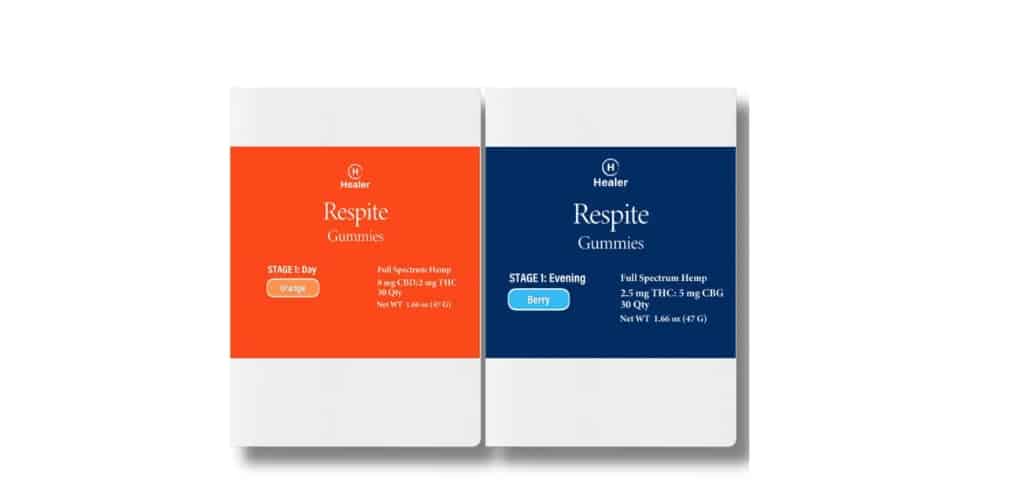Which CBD Is Best for Dementia Patients?
Posted on October 10th, 2023 to CBD by Healer Staff Writer
Dementia affects everything from cognitive processes and mood to sleep. CBD could potentially help negate some of the symptoms of dementia to enhance the quality of life. Find out more about using CBD for dementia symptoms below.
Try Respite Gummies for Dementia-Related Challenges
How does CBD treat dementia?
CBD does not treat dementia. However, the potential therapeutic properties of CBD may be beneficial for dementia patients. While CBD (cannabidiol) has not been proven to stop or reverse dementia symptoms, at least one peer-reviewed study suggests CBD could be beneficial for certain behavioral symptoms, such as aggression. Additionally, CBD may be an option for sleep support among dementia patients.
How to Use CBD for Dementia
CBD may be a supportive agent for an individual with dementia. Therefore, a regular usage with something like Healer Respite Gummies could be a good plan for everyday support. CBD may also be helpful in more acute situations, such as when a patient is feeling agitated or unsettled or just before bed to promote sleep.
How much CBD is needed for dementia symptoms?
Each patient can respond differently to cannabinoids. Therefore, it is a good idea to discuss dosage plans with a doctor on behalf of the patient and follow the start-low-go-slow process to determine the right dose. However, the general starting usage amount of CBD is 5mg to 10mg.
CBD products containing THC may work best
Current clinical studies are finding that THC, which the cannabis hemp plant also produces, works synergistically with CBD to increase the improvements in several symptoms in people with dementia including.
- Quality of life[iii]
- Behavioral symptoms like agitation[iv] and aggression[v]
- Pain[vi]
- Anxiety[vii]
- Sleep disturbance and nighttime wandering[viii]
- Low appetite and weight loss[ix]
- Stiffness and rigidity[x]
- Cognitive impairment[xi]
- Caregiver distress[xii]
Which CBD gummies are best for dementia?
The best gummies are full spectrum products (including naturally derived THC from hemp) made from organic certified hemp, with organic ingredients and lower amounts of sugar. The safest products have Certificates of Analysis that verify the product contains what it says on the label and is free from harmful contaminants. However, CBD gummies may not always be the best option for dementia patients especially if they can chew them. Gummies can take as long as an hour or more to take effect, while CBD oil drops can start working much faster. During acute instances of agitation, it can be important for effects to occur quickly.
Which CBD Is Best for Dementia Patients?
There are currently no CBD-based products approved by the FDA for dementia. Nevertheless, there are high-quality products available that are well-tested and come from reputable brands.
For example, Healer Respite Gummies are physician-developed, include a step-by-step user guide, and are lab-tested to prove they are free of contaminants and reliable. You can even get a free consultation about using hemp products by contacting Healer for advice. Therefore, if you are wondering where to buy CBD gummies for dementia, you can count on Healer.
Shop Gummies for Dementia-Related Challenges
What role does the endocannabinoid system play in treating Alzheimer’s disease?
The Role of the Endocannabinoid System in Treating Alzheimer’s Disease
The endocannabinoid system (ECS) has emerged as a compelling target in efforts to treat Alzheimer’s disease, offering multiple avenues for potential therapeutic intervention. Research involving animal models shows promising results for various components of the ECS.
CB1 Receptor Activation
In studies with rats, activation of the CB1 receptor has demonstrated a reduction in cognitive impairments. This effect primarily comes from lowering oxidative stress and stimulating neurogenesis, which is the formation of new brain cells. Enhanced neurogenesis can support cognitive functions and delay the progression of Alzheimer’s symptoms.
CB2 Receptor Activation
- Memory Improvement and Neuroprotection: In mice, CB2 receptor activation improved memory function through the cholinergic system (a vital part of the parasympathetic nervous system). It also helped protect hippocampal neurons from overexcitation.
- Inflammation Reduction and BDNF Increase: In another mouse study, CB2 receptor activation reduced inflammatory cytokines and increased levels of brain-derived neurotrophic factor (BDNF), a key molecule for brain health. Additionally, it decreased plaque formation and improved various types of memory.
FAAH Enzyme Inhibition
In mice, the inhibition of FAAH (fatty acid amide hydrolase), an enzyme responsible for degrading the endocannabinoid anandamide, has shown a significant decrease in inflammation in the brain’s microglia cells through various mechanisms. Similarly, in rat models with dementia, blocking FAAH results in brain protection and the preservation of spatial learning and memory.
Dual Inhibition of FAAH and MAGL
Another promising strategy involves the dual inhibition of FAAH and MAGL (monoacylglycerol lipase), the enzyme that breaks down 2-AG (2-Arachidonoylglycerol). This approach has notably reduced neuroinflammation, oxidative stress, and amyloid-beta (Aβ) plaques in mice. Aβ plaques are a hallmark of Alzheimer’s pathology, suggesting that this method could slow disease progression.
Genetics
Genetic problems with endocannabinoid retrograde transmission appear to be predictive of Alzheimer’s disease development.Overall, these findings indicate that the ECS’s manipulation can protect neurons, reduce inflammation, and possibly slow Alzheimer’s progression. Exploring ECS-targeted therapies holds significant potential for future Alzheimer’s treatments.
How does endocannabinoid signaling in microglia affect Alzheimer’s neuroinflammation?
Endocannabinoid signaling plays a pivotal role in regulating neuroinflammation, which is crucial for understanding Alzheimer’s disease. Research suggests that disruptions in retrograde endocannabinoid transmission may predict Alzheimer’s progression.
Key Mechanisms at Work
- CB2 Activation:
- Function: CB2 activation reduces excessive microglial activity.
- Outcomes: Decreased neuroinflammation.
- FAAH Enzyme Inhibition:
- Function: The FAAH enzyme breaks down anandamide, an important endocannabinoid.
- Outcomes: By inhibiting FAAH, scientists observed reduced inflammation related to microglia—the brain’s resident immune cells.
Implications for Alzheimer’s Treatment
These findings highlight the therapeutic potential of targeting endocannabinoid signaling to mitigate neuroinflammation in Alzheimer’s disease. By focusing on the manipulation of specific enzymes and pathways, there is promise for developing treatments that could slow or prevent the cognitive decline associated with this debilitating condition.
What alterations occur in the endocannabinoid system in Alzheimer’s disease?
The endocannabinoid system (ECS) undergoes several significant changes in individuals with Alzheimer’s disease. These alterations are documented through numerous studies, providing insights into how the ECS is involved in the disease’s pathology.
Key Changes
- Altered Endocannabinoid Levels
- Research indicates a discrepancy in the levels of endocannabinoids, such as anandamide and 2-AG, which play critical roles in brain function. These levels may either increase or decrease, contributing to disrupted neural communication.
- Receptor Modifications
- Post-mortem studies of AD brains have detected increased expression of CB1 and CB2 receptors on microglia within the senile plaque, while CB1 expression is reduced in more remote neurons from the plaque.
- Other studies have failed to establish a link between changes in CB1 receptors in the AD brain and the specific pathological events that take place in this illness.
- Enzymatic Activity Changes
- FAAH is upregulated in the senile plaque (Benito et al., 2003), and may contribute to the increase in expression of anandamide metabolites, such as arachidonic acid, in the vicinity of the senile plaque, which may be involved in increasing the production of prostaglandins and related pro-inflammatory molecules that are pertinent to the inflammatory process of AD.
- Synaptic Function
- The ECS plays a crucial role in synaptic plasticity and neurotransmission. Changes in ECS activity in Alzheimer’s patients affect synaptic function, potentially leading to the cognitive deficits characteristic of the disease.
Implications
Understanding these ECS alterations provides novel perspectives on potential therapeutic targets. Modulating ECS activity may offer pathways for mitigating symptoms or perhaps even slowing the progression of Alzheimer’s disease.
By exploring these various alterations, researchers can better appreciate the complex role the ECS plays in Alzheimer’s, paving the way for innovative treatment approaches.
How Might Inhibiting MAGL and FAAH Enzymes Treat Alzheimer’s Cognitive Impairment?
Inhibiting the enzymes MAGL and FAAH, which are responsible for breaking down endocannabinoids, has shown potential in treating Alzheimer’s cognitive impairment. Research in animal models, specifically mice, has demonstrated that blocking these enzymes can lead to significant reductions in neuroinflammation and oxidative stress. These two factors are critical contributors to the progression of Alzheimer’s disease.
Moreover, the inhibition of MAGL and FAAH has been linked to decreased levels of amyloid β plaques—protein aggregates commonly found in the brains of Alzheimer’s patients. These plaques are notorious for disrupting cell function and contributing to cognitive decline.
Key Findings:
- Reduction in Neuroinflammation: Diminishing inflammation in the brain helps to preserve neural function.
- Lowered Oxidative Stress: Protecting cells from oxidative damage slows down disease progression.
- Decrease in Amyloid β Plaques: Less plaque buildup means better preservation of cognitive abilities.
What potential does targeting the CB2 receptor have for treating Alzheimer’s disease?
Exploring the Potential of Targeting the CB2 Receptor for Alzheimer’s Treatment
Research suggests that targeting the CB2 receptor could hold significant promise for treating Alzheimer’s disease. Studies in animal models and neural tissues have demonstrated a range of beneficial effects when the CB2 receptor is activated.
Key Findings
- Memory Improvement: In mice, activating CB2 receptors has been shown to enhance memory through the cholinergic system, which is crucial for cognitive function.
- Neuroprotection: In rats, CB2 receptor activation protected neurons from hyperexcitation, a condition that can lead to neural damage.
- Inflammation Reduction: Another study in mice noted that CB2 activation reduced inflammatory cytokines. This decrease in inflammation is essential since chronic inflammation is a known factor in the progression of Alzheimer’s disease.
- Brain Growth Factors: The same research found an increase in brain-derived neurotrophic factor (BDNF), a protein that supports neuron survival and growth, crucial for maintaining cognitive functions.
- Plaque Reduction: Activating the CB2 receptor also contributed to a decrease in amyloid-beta plaques, which are heavily associated with Alzheimer’s pathology.
Conclusion
Targeting the CB2 receptor in the brain appears to offer a multi-faceted approach to combating Alzheimer’s disease. By improving memory, protecting neurons, reducing inflammation, and decreasing harmful plaques, CB2 receptor activation could potentially slow or even reverse some aspects of Alzheimer’s progression. Further research in humans is needed to fully understand its therapeutic potential.
How Does the Endocannabinoid System Affect Microglial Cells in Alzheimer’s Disease?
The endocannabinoid system (ECS) plays a significant role in modulating various physiological processes, including neuroinflammation, which is a hallmark of Alzheimer’s disease.
Key Mechanisms of ECS in Microglial Cell Regulation
- CB1 Receptor Activation
- Activation of the CB1 receptor in the brain has been shown to reduce cognitive impairment. This is achieved by decreasing oxidative stress and promoting neurogenesis, or the creation of new brain cells.
- FAAH Enzyme Inhibition
- The FAAH enzyme is responsible for breaking down anandamide, one of the body’s naturally occurring endocannabinoids. Inhibition of FAAH results in increased levels of anandamide, which has been observed to reduce inflammation in microglial cells. This reduction in inflammation occurs through multiple pathways and has protective effects on brain function and memory.
Real-World Implications
Research involving animal models has provided compelling insights:
- Rats: Studies involving rats have demonstrated that ECS modulation protects the brain from dementia-related damage, helping to preserve spatial learning and memory.
- Mice: Experiments with mice have shown that inhibiting FAAH reduces microglial inflammation, suggesting potential therapeutic benefits for treating Alzheimer’s disease.
Summary
In summary, the endocannabinoid system impacts microglial cells in Alzheimer’s disease primarily through two mechanisms: CB1 receptor activation and FAAH enzyme inhibition. These processes collectively help lower inflammation and oxidative stress, thereby protecting cognitive functions.
How Activating the CB2 Receptor Benefits Alzheimer’s Symptoms in Mice and Rats?
Activating the CB2 receptor has shown remarkable benefits in addressing Alzheimer’s symptoms in both mice and rats. Here’s a breakdown of the specific advantages observed in these animal models:
Memory Improvement
- In Mice: The activation of CB2 receptors has been shown to significantly enhance memory. This improvement is mediated through the cholinergic system—an essential part of the parasympathetic nervous system. This not only boosts memory but also lowers neuronal overexcitation.
- In Mice: Various types of memory benefited from a decrease in plaques and an increase in brain growth factor BDNF (Brain-Derived Neurotrophic Factor).
Neuroprotection
- In Rats: CB2 activation plays a vital role in protecting neurons from hyperexcitation, thereby offering a form of neurological shield.
- In Mice Neurons: Similarly, neurons in the hippocampus—the brain’s memory center—are safeguarded from amyloid-beta (Aβ) plaques, which are hallmark features of Alzheimer’s disease.
Inflammatory Reduction
- In Mice: Activation of CB2 receptors leads to lowered inflammatory cytokines, which are molecules that play a role in neuroinflammation—a common characteristic of Alzheimer’s disease.
By focusing on these areas, the CB2 receptor helps to mitigate some of the critical symptoms and progression markers of Alzheimer’s, offering a potential avenue for therapeutic strategies.
How did blocking both FAAH and MAGL enzymes impact Alzheimer’s symptoms in mice?
Blocking both FAAH and MAGL enzymes in mice demonstrated significant potential for alleviating Alzheimer’s symptoms. This dual action led to a noticeable reduction in neuroinflammation, one of the key contributors to Alzheimer’s pathology. Additionally, it decreased oxidative stress, which can further damage brain cells and exacerbate cognitive decline. Importantly, there was a reduction in amyloid β plaques, the hallmark of Alzheimer’s disease, suggesting a potential therapeutic approach to managing or slowing the progression of this condition.
What were the effects of inhibiting the FAAH enzyme in mice and rats with Alzheimer’s?
Effects of Inhibiting the FAAH Enzyme in Mice and Rats with Alzheimer’s
Inhibiting the FAAH enzyme, responsible for breaking down anandamide, led to reduced inflammation in the microglia of mice via multiple mechanisms. This intervention also protected the brain and preserved spatial learning and memory in rats with dementia. Additionally, a drug targeting both FAAH and MAGL (the enzyme that breaks down 2-AG) further decreased neuroinflammation, oxidative stress, and amyloid β plaque levels in mice.
Key Outcomes:
- Reduced Microglial Inflammation: Lowered inflammation in mice‘s microglia through varied processes.
- Brain Protection: Preserved brain function and spatial memory in dementia-affected rats.
- Decreased Neuroinflammation and Oxidative Stress: Alleviated neuroinflammation and oxidative stress in mice.
- Lowered Amyloid β Plaques: Reduced levels of harmful amyloid β plaques in mice.
Inhibiting FAAH thus demonstrates significant potential for mitigating Alzheimer’s-related damage and preserving cognitive function in animal models.
How did activation of the CB1 receptor affect cognitive impairment and neurogenesis in rats?
Activation of the CB1 receptor in rats had notable effects on both cognitive impairment and neurogenesis. Specifically, it helped reduce cognitive impairment by decreasing oxidative stress. Additionally, it promoted the formation of new brain cells, known as neurogenesis. These combined benefits suggest that CB1 receptor activation could play a crucial role in brain health and cognitive function.
What effects did cannabis terpenes have on neuroprotection in Alzheimer’s?
How Cannabis Terpenes Contribute to Neuroprotection in Alzheimer’s
Cannabis terpenes have shown promising effects in protecting nerve cells, particularly in the context of Alzheimer’s disease. Research has demonstrated that these terpenes can mitigate the harmful impacts of neurofibrillary tangles, which are characteristic of Alzheimer’s. By providing a protective barrier against these toxic tangles, terpenes help maintain neuronal health and function.
Key Findings on Neuroprotection:
- Inflammation Reduction: Some terpenes can reduce neuronal inflammation, a significant factor in Alzheimer’s progression. This anti-inflammatory action aids in preserving the structure and function of nerve cells.
- Cell Survival: In various studies, specific terpenes have been found to enhance the survival rates of neurons, even in environments that would typically promote cell death.
- Protection Against Toxicity: One of the primary issues in Alzheimer’s is the accumulation of toxic proteins that damage neurons. Cannabis terpenes act as protective agents, shielding nerve cells from these toxic assaults.
These effects collectively highlight the potential for cannabis terpenes to offer a natural therapeutic avenue for neuroprotection in Alzheimer’s disease.
What is the connection between the endocannabinoid system and the gut microbiome in Alzheimer’s?
Understanding the Link Between the Endocannabinoid System and Gut Microbiome in Alzheimer’s
Recent research has illuminated the complex relationship between the endocannabinoid system and the gut microbiome in the context of Alzheimer’s disease. These two biological systems appear to interact in a manner that influences the progression and symptoms of Alzheimer’s.
The Endocannabinoid System’s Role
The endocannabinoid system (ECS) is crucial for maintaining homeostasis in the body. It regulates various physiological processes, including inflammation, pain sensation, and immune response. Dysregulation of the ECS has been linked to neurodegenerative diseases, such as Alzheimer’s.
The Gut Microbiome’s Influence
The gut microbiome consists of trillions of microorganisms that reside in the digestive tract. These microbes play a vital role in digestion, immune function, and even brain health. An imbalance in the gut microbiome, known as dysbiosis, has been found to correlate with several chronic conditions, including Alzheimer’s disease.
Bridging the Connection
- Neuroinflammation: Dysbiosis in the gut microbiome can lead to increased permeability of the gut wall, often referred to as “leaky gut syndrome.” This condition allows inflammatory agents to enter the bloodstream and reach the brain, which can exacerbate neuroinflammation—a hallmark of Alzheimer’s disease. The ECS, through its anti-inflammatory properties, might mitigate this process.
- Gut-Brain Axis: The ECS is an integral part of the gut-brain axis, a bidirectional communication network between the gastrointestinal tract and the central nervous system. Endocannabinoids in the gut can influence the microbiome composition and vice versa. This interplay is thought to affect cognitive functions and might offer pathways for therapeutic intervention in Alzheimer’s.
- Amyloid Beta Plaques: Some studies suggest that the gut microbiome can influence the formation and accumulation of amyloid-beta plaques in the brain. The ECS may help modulate this process, potentially slowing down the development of Alzheimer’s.
Potential Therapeutic Implications
Understanding the interaction between the ECS and gut microbiome opens new avenues for Alzheimer’s treatment. For instance:
- Probiotics: Introducing beneficial bacteria to restore gut balance.
- Cannabinoid-Based Therapies: Utilizing cannabinoids to modulate the ECS and reduce neuroinflammation.
In summary, the connection between the endocannabinoid system and the gut microbiome presents a promising field of study that could lead to innovative treatments for Alzheimer’s disease.
What is the significance of endocannabinoid retrograde transmission in predicting Alzheimer’s?
The Role of Endocannabinoid Retrograde Transmission in Predicting Alzheimer’s
Endocannabinoid retrograde transmission plays a crucial role in the brain’s signaling system. Alterations in this process can serve as early indicators of Alzheimer’s disease. Understanding these genetic changes helps researchers identify individuals who may be at higher risk for developing the condition.
Key Points:
- Brain Function: Endocannabinoids impact various brain functions, including memory and mood.
- Early Detection: Genetic disruptions in this system can signal the onset of Alzheimer’s before symptoms appear.
- Research Focus: Scientists are examining these disruptions to develop early diagnostic tools and treatments.
By monitoring changes in endocannabinoid signaling, researchers can improve early detection methods, leading to better outcomes for those at risk of Alzheimer’s.
The information in this post/article is provided for educational purposes and is not a substitute for or alternative to information from your healthcare providers. Statements and claims on this website have not been evaluated by the Food and Drug Administration. Any products mentioned are not intended to diagnose, treat, cure or prevent any disease.
References.
[i] Shelef, Assaf, et al. “Safety and efficacy of medical cannabis oil for behavioral and psychological symptoms of dementia: an-open label, add-on, pilot study.” Journal of Alzheimer’s disease 51.1 (2016): 15-19.
[ii] Hermush, Vered, et al. “Effects of rich cannabidiol oil on behavioral disturbances in patients with dementia: A placebo controlled randomized clinical trial.” Frontiers in Medicine 9 (2022): 951889.
[iii] Pautex, Sophie, et al. “Cannabinoids for behavioral symptoms in severe dementia: Safety and feasibility in a long-term pilot observational study in nineteen patients.” Frontiers in Aging Neuroscience 14 (2022): 957665.
[iv] Hermush, Vered, et al. “Effects of rich cannabidiol oil on behavioral disturbances in patients with dementia: A placebo controlled randomized clinical trial.” Frontiers in Medicine 9 (2022): 951889.
[v] Woodward, Matthew R., et al. “Dronabinol for the treatment of agitation and aggressive behavior in acutely hospitalized severely demented patients with noncognitive behavioral symptoms.” The American Journal of Geriatric Psychiatry 22.4 (2014): 415-419.
[vi] Flávio Henrique de Rezende Costa., et al. “Parkinson’s Disease and Dementia with Lewy Bodies, Patients Under Treatment withStandardized Extracts Enriched in Cannabidiol and Cannabigerol: Descriptive Observations in Preparation for a Phase 2a Clinical Trial”.EC Neurology 14.5 (2022): 01-15.
[vii] Flávio Henrique de Rezende Costa., et al. “Parkinson’s Disease and Dementia with Lewy Bodies, Patients Under Treatment withStandardized Extracts Enriched in Cannabidiol and Cannabigerol: Descriptive Observations in Preparation for a Phase 2a Clinical Trial”.EC Neurology 14.5 (2022): 01-15.
[viii] Walther, Sebastian, et al. “Delta-9-tetrahydrocannabinol for nighttime agitation in severe dementia.” Psychopharmacology 185 (2006): 524-528.
[ix] Volicer, Ladislav, et al. “Effects of dronabinol on anorexia and disturbed behavior in patients with Alzheimer’s disease.” International journal of geriatric psychiatry 12.9 (1997): 913-919.
[x] Broers, Barbara, et al. “Prescription of a THC/CBD-based medication to patients with dementia: a pilot study in Geneva.” Medical Cannabis and Cannabinoids 2.1 (2019): 56-59.
[xi] Palmieri, Beniamino, and M. Vadalà. “Oral thc: cbd cannabis extract in main symptoms of Alzheimer disease: agitation and weight loss.” La Clinica Terapeutica 174.1 (2023).
[xii] Palmieri, Beniamino, and M. Vadalà. “Oral thc: cbd cannabis extract in main symptoms of Alzheimer disease: agitation and weight loss.” La Clinica Terapeutica 174.1 (2023).




